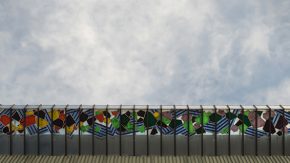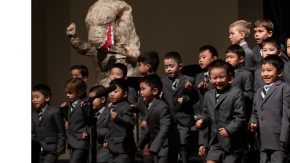PYP – Exhibition and Action
Completing the third inner circle of the Primary Years Programme (PYP) there are two aspects of PYP that support agency – exhibition and action. The exhibition is an annual event that allows the senior year of our school, Year 6, to showcase their skills, learning and understanding on an issue they are passionate about that has consequence at a local or global nature. Learning in the PYP provides many formal and informal opportunities for students to demonstrate how they have developed and applied their knowledge, conceptual understandings, skills and learner profile attributes through the inquiries they undertake. The PYP exhibition is a notable example of these opportunities.
In the exhibition, students demonstrate their understanding of an issue or opportunity they have chosen to explore. They undertake their investigation both independently and with their peers with the guidance of a mentor. Through the exhibition, students demonstrate their ability to take responsibility for their learning—and their capacity to take action—as they are actively engaged in planning, presenting and assessing their learning on an issue or passion.
The exhibition is a powerful demonstration of student agency, as well as the agency of the community that has nurtured them through their years in the PYP. The learning community participates in the exhibition, supporting and celebrating the development of internationally minded students who make a positive difference in their lives and the lives of others. All exhibitions are student-initiated, designed and collaborative.
The exhibition is based on a local or global issue or opportunity, from which teachers and students develop central ideas. These issues or opportunities are open to perspectives across the transdisciplinary themes and are complex enough to be addressed through a range of subject knowledge and skills. At the beginning of the exhibition process, students and teachers extensively discuss local or global issues and opportunities that have meaning to them and connect to the school or local contexts. The students are aware that the exhibition is a collaborative inquiry involving all students in the grade group. They regularly share work in progress and demonstrate a genuine sense of participation in a collaborative effort.
Action, the core of student agency, is integral to the PYP learning process and to the programme’s overarching outcome of international mindedness. Through taking individual and collective action, students come to understand the responsibilities associated with being internationally minded and to appreciate the benefits of working with others for a shared purpose. When students see concrete actions that they can choose to take to make a difference, they see themselves as competent, capable and active agents of change (Oxfam 2015).
Action is a means for students to show that they have linked their learning to real-life issues and opportunities, and that they are developing responsible personalities and behaviours towards social and physical environments and to the community within and beyond school. Through action, students develop a sense of belonging to local and global communities. They understand and recognize the interconnectedness and interdependence of issues, and consider these from multiple perspectives (Oxfam 2015, UNESCO 2015).
Initiated by students, PYP action is authentic, meaningful, mindful, responsible and responsive. Action could be:
- a change in attitude
- a consideration or plan for action in the future
- a demonstration of responsibility, or of respect for self, others and the environment
- a commitment to leading or participating in a youth advocacy group
- an engagement in school decision-making or an expression of support in community, local and global decision-making.
Students exercise agency by making responsible choices; these choices can sometimes include conscious decisions not to act. It may be that students take time to research and reflect upon possible courses of action and decide against taking action because of the connected consequences and potential impact on others. Students take action in response to their inquiries or motivation to make a positive difference, bring about positive change or further their learning. As an integral part of the learning process, action can be embarked upon at any point and can take many forms.
Action can be short or long term, revisited or ongoing. It may be individual or collective, small or large scale and may take place at home, at school or in local or wider communities. Some actions may not always be visible or immediately impactful; they might appear in the form of impressions left on students, or small things that go unnoticed because they are part of the daily life of the learning community.
For our younger students, action may start with small adjustments of behaviour, which may include the development of responsible behaviours towards themselves and others, and in making appropriate choices.
Action is responsive to experiences that are personally meaningful and, as with all action, is authentic, reflective and mindful.
Sue Gough – PYP Co-ordinator






